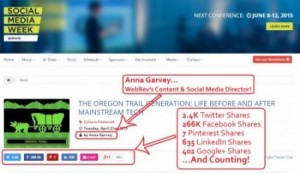
A well-done case study is a fantastic, evergreen piece of content. No wonder they rank as the most effective form of written B2B content, and third most effective B2B content marketing tactic overall – just behind in-person events and webinars.

Producing a case study requires an extra amount of client and project management in order to get buy-in and participation from the client. Coupling the costs of producing a case study with its inherently high value makes case studies rich ground for repurposing.
When you create a case study – or any piece of content – it can be either a flash in the pan or an asset generating ongoing value. When you do nothing with your case study but post it on your website along with your other case studies, it sits on the “flash in a pan” side of the continuum.
To repurpose your case study, you re-use its content and other content elements generated in the process of creating the case study. Repurposing is what converts a piece of content into an ongoing marketing asset. Looking for ROI on your content creation? Repurposing is a key strategy.
Case studies are particularly well suited to repurposing because the content generated to create the case study is evergreen. A success story will always be a success story. Even if your company stops offering the product or service that’s central to one case study, it remains a real world example of the kind of success your company can accomplish.
What Makes Case Studies So Valuable
The power of the case study isn’t only because it’s a success story. It’s a success story being told by a client. It’s a testimonial with exponential influence. According to Demand Gen’s 2016 Content Preferences Survey, case studies are seen as containing independent analysis about a product or service, which is critical during the decision stage. 72% of the survey’s respondents said case studies were the most valuable type of content viewed during their decision-making process, trailing only third party reports, which came in at 77%.

B2B buyers want to hear from similarly-situated companies. They’re risk-averse and want assurances of how your product or service has worked in the real world. They want validation they can share with the rest of the buying committee and senior management.
If you want an excellent, detailed look at how to create an effective case study, check out CopyBlogger’s great article on how to write a case study.
In the meantime, here are the basic building blocks of preparing a case study and the final product. You should start seeing the repurposing possibilities.
- Client interview[s]
- Research of quantifiable metrics, including what the client is willing to share for publication
- Summary sidebar
- Data point graphic(s)
- Client provided images
- Headline and subheader options
- Substantive content laying out the journey from problem to be resolved to challenges in finding and implementing the solution, and on to success
Consider all these components part of your case study ingredients, which can be endlessly remixed with other content ingredients into multiple content stews.
Repurposing Multipliers
How can you present the same information in different formats so it reaches the broadest swath of people regardless of their preferred way to consume content? Then, how can you emphasize different aspects of the story to appeal to people and personas with different priorities? That’s what repurposing multipliers are all about. The main repurposing multipliers are format and perspective.
Format Variety
The format list includes long and short form content, audio and visual content, and graphics and images. Format variety also includes whether the repurposed content is stand-alone or part of another piece of content. A common way to repurpose a case study is to have both long and short form. They’re still both the case study. The short form can also be easily tweaked to be a blog post directing people to download the complete case study or another piece of related, longer form content.
But repurposing your case study content can also be a matter of dropping bits of information or content from the case study into entirely different pieces of content. Every case study you put together should have a summary sidebar, which usually is contained in a graphic element. Once you have a number of case studies, you can curate all the sidebars into a single infographic.
Perspective Variety
Let’s say you’re a workforce scheduling SaaS and you organize your case studies by industry. That makes good sense. A hospital has different staffing needs than a fulfillment center. But they both have HR departments. They both have people in management who need to accurately forecast staffing needs.
If you’re collecting the right scope of information from clients during each case study’s research phase, you’re more likely to get the kind of information you can re-package in multiple ways.
When our workforce scheduling software company starts putting together a white paper for its “Harriet, Head of HR” persona, it has a wealth of content to insert into the white paper. It has a variety of HR manager testimonial quotes and HR-relevant success metrics already pulled from case study interviews. Weaving its own client success content into its white paper on topic XYZ differentiates that company’s white paper from all the other scheduling software companies writing about the same topic.
Now the company’s white paper not only provides unique information to the reader by way of sharing real world examples and perspectives, it’s also reinforcing the company’s own value.
Creating a Case Study with Repurposing in Mind
Planning upfront, before you start doing the interviewing and research to put the case study together, will go a long way to maximizing the repurposing value of your case study. Indeed, done well, you can create multiple case studies from the same planning.
Now most of the prep work here requires consent from the client being profiled in the case study. You don’t want to have to keep going back to the client to ask for more permission to do more. Depending on how much you want to do with the case study content, here are some things to ask the client for permission or commitment to do up-front:
- Record their interviews, either video or audio-only
- Share publicly some of their internal metrics
- Provide some photos, either of interviewees and/or hero image demonstrating some aspect of the client’s usage of your product or service
- Agree to let you use the content they’re giving you to create the case study (interviews, images, metrics) outside of the case study itself
Some clients are more comfortable with all this than others. Use your knowledge of any specific client to gauge what you can ask for and what not to bother about.
Once you start collecting the underlying information, you want to pull together a lot more than you can effectively use in just one case study. A typical case study interview can run from 30 minutes to an hour. You never use the entire transcript, or even just every bit of information shared in the interview in the end case study, right? Well, don’t throw away the rest of that content just because it didn’t make it into the case study you’re currently putting together.
To ensure you’re collecting all the information you need for the case study and its repurposing, standardize your interview process.
- What are the ideal role(s) in the company to be interviewed
- What background information do you want to have before you interview anyone on the client side
- Use a standard list of interview questions, which you can tweak to dig deeper into this client’s particular story
- What are the common success metrics you want to have (e.g., our scheduling software company may want to get numbers on how its software improved staffing forecasting accuracy from all its case study subjects)
Take the same approach with all the metrics and images you collect from the client. Give the client some guidance as to what sort of metrics and images will be helpful. This way, you can collect some standardized information you can curate from other case study participants to create new content.
Having said that, be responsive to stats and photos your client wants to give you to use. Your client isn’t just participating in the case study because they love you (although that’s probably part of the reason why). Your client understands the case study is content they can use as well. Content they don’t have to pay for. They’re doing you a favor by participating, so let them take advantage of the opportunity to distribute some of their information that reflects their priorities. Another good reason to let the client share with you the metrics and images they want – it’s good, current intel on what matters most to them.
If you plan your case study with repurposing in mind and collect the information you need to enable high-powered repurposing, you should finish the collection process with a hefty chunk of content you can now use in countless ways (I’ll count some of them out a bit further down.)
“I already have a bunch of case studies. I didn’t plan them this way!!”
Not a problem. Planning out and collecting this scope of information is an ideal scenario, one you should try to put into practice to the degree possible. At the very least, get agreement from the client that you can use what they do provide in future content and standardize your interview process.
But back to your current case studies. As I wrote earlier, case studies are awesome because they’re evergreen. Whatever content you do have in the case studies you’ve already done can yet be repackaged and reused in multiple ways. If you still have the transcripts or recordings of the interviews, you probably have a lot more information available as well, so go back and take a second look.
On to the Repurposing Ideas
From a content creation viewpoint, there are three ways to execute a piece of repurposed content:
- Re-formatting
- Re-working
- Original
Reformatting means taking a piece of the case study as it is and, with minimal extra work required, turning into a new format. This could be curating a bunch of your online case studies into a Flipboard or using rejected headline ideas as social media content promoting the case study. It could be editing down an audio or video recording into its own mini-case study, or just editing it into testimonial clips that can be embedded on a landing page or lead nurturing email.
Re-working and original content requires a bit more effort and may use content collected that didn’t make it into the final case study. You might convert a written case study into a slide deck presentation. Another example is to create a new graphic that shares a data point you’ve generated from analyzing the data provided by case study subjects. Use the graphic in social media and landing pages.
I’ve been peppering this post with specific repurposing ideas. Let me make it easy here:
21 Content Ideas for Repurposing a Case Study
Let’s start with case study itself:
- Complete, long form case study
- Short form case study, which can be tweaked into a blog post or newsletter article
- Slide deck version of case study
- Edit audio or video recording into its own case study
- Rewrite the case study as a series of informative articles for relevant trade publications
- Present the journey described in the case study graphically
- Curate online case studies into Flipboard or other online compiling tool
- Curate all the sidebars into a single infographic or presentation
- Drop data graphics created for the case study into blog posts or white papers
- Optimize an “old” case study for a new audience or to take advantage of any SEO changes
- Chop up the bewhatzis out of it to generate snackable social media bites (this applies to unused case study content too)
Gaining value from content collected for the case study, but not necessarily used in it:
- Convert rejected headlines and subheaders into a go-to social media bank for promoting the case study
- Insert on-point testimonials from client interview into other content, written or graphic, and video or audio if you have it. These could be in hard copy brochures, white papers, landing pages, presentations, webinars, etc
- Use the case study as the basis of a press release with focus on a staggering success metric
- Analyze data provided by multiple case study participants to generate some meta-data and conclusions that can be the form
- Curate data points, quotes, and graphics used in case studies into visual formats such as social media graphics or new slide deck presentations
- Find common themes among case study interviews that can be used as angles for new articles, whether used as your own blog posts or newsletter articles, or pitched to other sites or trade publications
- Curate your short form case studies into industry or persona segmented reports (or any other format)
- Create a best practices white paper or “Top 10 Tips” cheat sheet using the client feedback; this might regard implementation challenges or improving a certain performance metric
- Create a decision tree graphic that displays what questions clients asked themselves during their decision-making process and how their answers lead them to your company
- Use edited portions of audio and/or video content in webinar
The one – critical – element I’ve left out so far are the distribution channels. I don’t consider the channels repurposing directly since they’re not the content itself. However, distribution is critical to effective use of content.
So I invite you to get creative and expansive with all the distribution channels you select to use for all this repurposed content, as channel variety is another multiplier. So whether it’s cross posting different pieces of repurposed content on sites like Medium, GrowthHackers, YouTube, etc, diversify your distribution options with the same gusto as you’ve given the repurposing.
What’s your best case study repurposing project? Share it below in the comments section.
Business & Finance Articles on Business 2 Community(142)
Report Post






